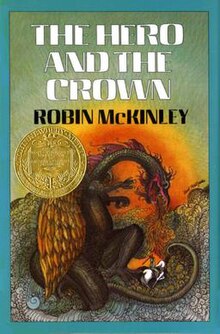Part one
Aerin is the only child of Arlbeth, king of Damar, and his second wife. Aerin inherits her mother's pale skin and fiery red hair, setting her apart from all other Damarians and causing her to be feared and ostracized. Her particular nemesis at court is Galanna, a beautiful but vain young woman, who spread rumors that Aerin's mother was a witch and that Aerin is illegitimate. Galanna taunts Aerin for having failed to develop the Gift, known as kelar, an ability to use magic that all members of the royal family inherit to some degree. During one of their regular fights, Galanna convinces Aerin to eat the leaves of the surka plant, which is poisonous to all those not of royal blood. While eating the surka plant does not kill Aerin, it makes her extremely ill.
During her recovery, Aerin stumbles upon a book about the history of Damar and the enormous dragons of old that used to terrorize it, of which only much smaller relatives still exist. Seeking privacy in the pasture of her father's now-injured war horse, Talat, Aerin reads through the book while forging a friendship with the stubborn and proud horse. At the back of the book she finds a recipe for kenet, an ointment meant to protect the wearer from the effects of fire. While experimenting with the ointment, she also trains herself on mounted combat with Talat. Eventually, she sneaks off to slay a small dragon that has been terrorizing a village. Her success earns her some minor notoriety and requests for assistance from other villages. In the meantime, trouble comes from the north, in the form of one of the western barons, Nyrlol, who threatens civil war.
Part two
Arlbeth fears that the Hero's Crown, an item of power, has finally fallen into the hands of the demonic Northerners, and that Nyrlol's madness is a symptom of their growing power. He is forced to ride west with many of his court, including Tor (his male heir and Aerin's only friend), to deal with Nyrlol, but denies Aerin's request to join him. However, just as Arlbeth prepares to ride north, a messenger arrives bearing news that the last of great dragons, Maur, has reappeared and is terrorizing Damar. Arlbeth has no choice but to deal with Nyrlol first. But Aerin, having been left behind, decides to fight Maur on her own.
After a tremendous battle, Aerin narrowly defeats Maur, claiming as her trophy a red stone left behind when his body burns itself to ashes. Aerin is severely injured but manages to drag herself onto Talat, who carries her home. Maur's skull is brought to the castle as a trophy but its presence seems to taunt Aerin and her health does not improve. In her declining state, Aerin dreams of a blond man by a lake who beckons her to come to him so that he may help her. Aerin leaves Tor a note and rides off on Talat to find this man, Luthe.
Luthe, a sorcerer, heals Aerin by placing her in the Lake of Dreams, which causes her to become "no longer quite mortal". Luthe teaches her some magic and Aerin learns that it is the kelar that gives the royal family their magical abilities. Luthe then reveals that Aerin's mother and uncle, Agsded, along with Luthe, were students of a master mage. Agsded was the best student but used his abilities for evil. A prophecy foretold that one of Agsded's own blood would defeat him; in fear, Aerin's mother fled to the south to have a child (Aerin) with Arlbeth. When Aerin is fully recovered, Luthe sends her north with the dragon's red bloodstone and Gonturan, The Blue Sword, to challenge Agsded.
As she travels, Aerin is joined by armies of foltsza (large mountain cats) and yerigs (large wild dogs). After an extensive magical battle in which Agsded is eventually defeated and the Hero's Crown is recovered, Aerin is rescued by Luthe, who escorts Aerin back as far as his lake on her way home. They become romantically involved; Aerin leaves him but promises to return one day, as they are both immortal.
She returns to find the kingdom losing a battle with the Northern demons. Using Gonturan and her army of foltsza and yerigs, and giving the Hero's Crown to Tor, she helps defeat the Northerners, but at the cost of many lives, including Arlbeth's. Aerin, with Tor's help, finally rids the kingdom of Maur's evil skull, but in the process the skull turns Damar into a desert. Aerin marries Tor, whom she truly loves in her own way, and they help rebuild the kingdom together as its rulers.
